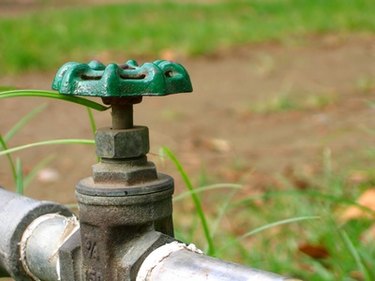
You can calculate the flow rate, volume and pressure in a water tank using formulas from physics. Volume is the amount of space that an object takes up, and may be measured in liters, gallons, or cubic meters. Flow is the rate at which a certain volume of liquid passes through an opening; it may be measured in liters per second or gallons per minute. Pressure is the amount of force per square unit of area, and is measured in pounds per square inch (psi) or Newtons per square meter (pascals).
Calculating Volume
Video of the Day
Step 1
Measure the width, length and height of the water in meters.
Video of the Day
Step 2
Multiply the width, length and height to compute the volume in cubic meters. The formula is V = WLH, where V is the volume, W is the width, L is the length and H is the height.
Step 3
Convert cubic meters to liters by multiplying by 1,000. Convert cubic meters to gallons by multiplying by 264.17.
Calculating Water Flow
Step 1
Place an empty container below the faucet or release valve.
Step 2
Open the valve and use the stopwatch to time the water flow for 15 seconds.
Step 3
Measure the number of liters or gallons in the container, and divide that number by 15. This gives the flow rate in liters per second or gallons per second. The formula is F = V/T, where F is the flow rate, V is the volume and T is the time.
Step 4
To convert to liters per minute or gallons per minute, multiply the number you obtained above by 4.
Calculating Pressure
Step 1
Use the hydrostatic pressure formula P = pgh, where p is the density of water in kg per cubic meter, g is the gravitational acceleration constant, h is the height of the water above the valve in meters and P is the pressure in pascals.
For water near the surface of the earth, p = 1,000 kg per cubic meter, and g = 9.81 meters per second squared.
Step 2
Convert pascals to psi by dividing by 6,894.76.
Step 3
Use this example as a guide to calculate water pressure in a tank.
The height of the water in a tank is 4 meters above the valve. Applying the hydrostatic pressure formula gives you P = (1,000)(9.81)(4) = 39,240 pascals. In pounds per square inch, the pressure is 39,240/6,894.76 = 5.69 psi.